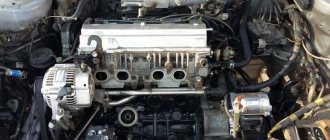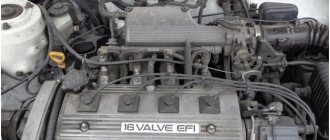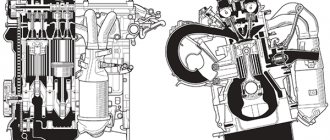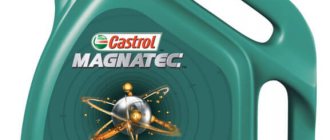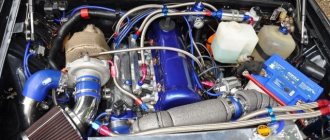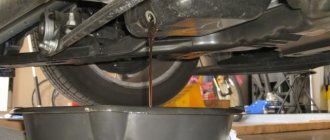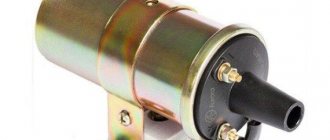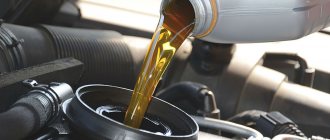The first example of the famous six-cylinder 1JZ engine was released in 1990 , installed on the Mark in the 80th body . The engine design is based on the “progenitor” 7M: a cast-iron six-cylinder block, the cylinder head is equipped with twenty-four valves, timing, belt driven and distributor ignition.
Toyota Mark II 80 body
But the 1JZ engine underwent some improvements: an ACIS mechanism that changed the intake geometry, the attachments were now on one ridge belt , and the oil pump was replaced with a reliable, productive trochoid type .
The first samples, produced from 1990 to 1995 , produced 180 horses , a tractive effort of 235 Nm at 4800 rpm.
In 1996, the automotive world saw the result of modernization - 1JZ-GE , which, unlike its predecessor, received variable valve timing VVT-i , new coil ignition DIS-3 , where each coil works with its own pair of spark plugs. The new Jazzys already had 200 hp. With. and produced a torque of 251-255 Nm at 4000 rpm .
Engine 1JZ-GE
1jz ge
This engine is produced by the Japanese company Toyota.
The engine is in-line, has 6 cylinders, runs on gasoline, has replaced the line of M engines. All modifications of the 1jz have a DOCH gas distribution mechanism with four valves for each cylinder (24 valves in total). Available in volumes of 2.5 and 3.0 liters. Automotive power units 1jz are mounted longitudinally for rear-wheel drive and all-wheel drive vehicles.
The first jz series engine was released in 1990. The last one was in 2007. After 2007, the line of Toyota JZ engines was replaced by the new GR V6 series.
List of modifications 1JZ GE
There are 2 main modifications of this engine:
- The 1JZ-FSE D4 is a direct injection powerplant that produces 200 hp. With. The engine was produced in the period 2000-2007;
- 1JZ-GTE is a turbocharged version, initially operating on two turbines. Then, after the 1996 modernization, only one turbine was left, a VVTi system was added, and the compression ratio was increased to 9.
The power of the modified analogue 1JZ-FSE D4 is the same as that of the naturally aspirated one. In the turbocharged version 1JZ-GTE it is 80 hp higher. With.
Technical characteristics of the Toyota 1JZ-GE 2.5 liter engine
First generation 1990 without VVT-i
| Type | in-line |
| Number of cylinders | 6 |
| Number of valves | 24 |
| Exact volume | 2492 cm³ |
| Cylinder diameter | 86 mm |
| Piston stroke | 71.5 mm |
| Supply system | injector |
| Power | 180 hp |
| Torque | 235 Nm |
| Compression ratio | 10 |
| Fuel type | AI-92 |
| Environmental standards | EURO 2 |
Second generation 1996 with VVT-i on the intake
| Type | in-line |
| Number of cylinders | 6 |
| Number of valves | 24 |
| Exact volume | 2492 cm³ |
| Cylinder diameter | 86 mm |
| Piston stroke | 71.5 mm |
| Supply system | injector |
| Power | 200 hp |
| Torque | 255 Nm |
| Compression ratio | 10.5 |
| Fuel type | AI-95 |
| Environmental standards | EURO 3 |
Motor specifications
Summary table of technical characteristics of the 1JZ-GE engine
| Engine capacity | 2.5 l. |
| Power indicator | From 180 to 200 hp |
| Cylinder radius | 43 |
| Additional information about the motor | 3 |
| Fuel fluid type | Gasoline fuel with 98 octane number |
| Maximum power parameters | 180 hp (132kW) / 6 thousand rpm. 180 hp (132 kW) / 6.2 thousand rpm. 196 hp (144 kW) / 6 thousand rpm. 200 hp (147 kW) / 6 thousand rpm. |
| Maximum torque parameters | 235 Nm (24 kg*m) / 4.8 thousand rpm 250 Nm (26 kg*m) / 4 thousand rpm 255 Nm (26 kg*m) / 4 thousand rpm |
| The presence of a mechanism for changing the volume of cylinders | absent |
| Minimum and maximum fuel consumption values | 5.9 and 16.7 liters per 100 km. |
| Availability of a start-stop system | absent |
| Compression levels | From 9 to 11 |
| Type of motor installation | 6-cylinder, 24-valve, DOHC, liquid cooled |
| Piston stroke | 72 mm |
Description of the 1JZ GE engine
The 1JZ GE inline six is the successor to the 1G engine. Began to be produced in 1990. The first generation was equipped with a distributor; after restyling, coil ignition was installed. Since 2003, the engine has replaced the more advanced 4GR-FSE.
The 1JZ GE uses: a cast iron block, 2 camshafts, and a timing belt. A broken belt does not bend the valve, which prolongs the life of the power unit. The engine does not have hydraulic compensators. The valves must be adjusted manually, every 50 thousand km, using special adjustment washers. The internal combustion engine is not complicated, even a beginner can figure it out.
In 1996, the 1JZ GE engine underwent restyling. The manufacturer modernized the cooling and gas distribution systems, and changed the cylinder head for the engine. The modernization introduced the VVTi system and increased the compression ratio. Ignition coils appeared instead of a distributor. The power of the modernized aspirated engine was 200 hp. With.
The VVTi system was introduced to engines after the 1996 restyling. This is a unique Toyota development of the gas distribution mechanism, meaning an intelligent change in valve timing
1JZ engine characteristics
The first turbo version of the 1JZ is the 1JZ-GTE engine.
The main qualities of the 1JZ engine are reliability , service life , and potential for tuning . Therefore, he has earned the trust and love of car enthusiasts.
Specifications:
- produced between 1990 and 2007
- exact displacement: 2492 cm³
- power depends on the 1JZ modification: 6000 rpm - 170 horses , 6000 rpm - 200 horses , 6200 rpm - 280 horses
- torque: 4800 rpm - 235 Nm , 4000 rpm - 251 Nm , 4800 rpm - 363 Nm , 2400 rpm - 379 Nm
- each model differs in compression ratio: 1JZ-GE - 10:1 , -GE VVT-i - 10.5:1 , 1JZ-GTE - 8.5:1 , -GTE VVT-i - 9:1 , 1JZ-FSE D4 — 11:1
- has average statistical indicators for lubricant change intervals: every 10,000 km , preferably every 5,000 km
- has a relatively high permissible oil consumption: up to 1000 g per 1000 km
- Cars with this engine and its modifications differ in the required oil volume . 1JZ-GE : 1995-1998 (Crown 2WD) - 5.1 liters ;
- 1998-2001 (Crown 2WD) - 5.4 liters ;
- 1995-1998 (Crown 4WD) - 4.2 liters ;
- 1998-2001 (Crown 4WD) - 4.5 liters ;
- 1991-1992 (Crown, Crown Majesta) - 3.9 liters ;
- 1992-1993 (Crown, Crown Majesta) - 4.4 liters ;
- 1993-1995 (Crown, Crown Majesta) - 5.3 liters
- Mark 2, Cresta, Chaser 2WD - 5.4 liters ;
- 2WD - 5.4 liters ;
with responsible operation, the service life of the 1JZ engine will be approximately 400 thousand km
Fuel consumption
The engine shows acceptable fuel consumption considering its power. In the city, 15 liters per 100 km , on the highway the consumption drops to 9-10 liters per hundred , and in the combined cycle the consumption figures will be 12.5 liters .
Motor modifications
The engine was produced in three versions , each with its own characteristics.
Motor 1JZ-GE
- Motor 1JZ-GE - the ancestor, the main option atmospheric type. Issued during 1990—1996 yy., issued 180 horses, compression 10:1. But after the first modifications 1996, as a result of which he received VVT-i system, coil ignition, improved cylinder head And connecting rods, power has increased up to 200 hp, and the compression ratio increased up to 10.5. The second version provided increased dynamics while simultaneously reducing fuel consumption compared to the first version.
Engine 1JZ-FSE D4 on Toyota Mark II 110 - Engine 1JZ-FSE D4 - version equipped with direct injection D4, where the fuel mixture is supplied under high pressure. The modification was released with 2000 before 2007 year, had the same power in 200 hp, compression moment 11. The engine began to consume less gasoline, and the torque at low speeds increased. At the same time, the cost of servicing the intake and fuel system has increased.
Engine 1JZ-GTE - The 1JZ-GTE engine - the first turbo version based on the classic engine was released in the same 1990 , received a double turbocharger with a pressure of 0.7 bar due to the installation of two CT12A turbines , replacement of the piston group , improvement of the cylinder head together with Yamaha . This engine developed 280 hp. at 6200 rpm , compression ratio 8.5. In 1996 a restyled version was released , one larger ST-15B was installed , as well as the VVT-i system, . Despite the fact that the power remained at the same level of 280 horses , the compression ratio increased to 9 , and the torque increased from 363 Nm to 378 Nm .
Disadvantages and weaknesses of the 1JZ engine
Despite the fact that the 1JZ engine is known for its reliability and durability , it still has a number of disadvantages and weaknesses. What problems usually arise and what are the ways to solve them:
- VVT-i valve and coupling. The short-lived life of these elements often leads to floating speed and knocking in the engine. After replacing them the problem goes away.
VVT-i valve for 1JZ-GE engine - Afraid of washing and frost . In the case when the engine is “flooded” and frozen, it is enough to dry the spark plugs and cylinders.
- High fuel consumption. Associated, as a rule, with a failed lambda probe. It is advisable to replace the oxygen sensor, as well as the air filter and possibly the mass air flow (MAF) sensor.
Oxygen sensor (lambda probe) for 1JZ-GE engine - Increased oil consumption . If the engine mileage is high, the rings and valve stem seals probably need to be replaced. The more effective method is to replace the motor with a contract one.
Review of faults 1JZ GE
The motor is considered reliable, but malfunctions, one way or another, arise over time. Let's look at the most well-known, common problems:
- Startup problems. The cause is usually related to the spark plugs. They need to be checked and, if necessary, cleaned or replaced. It is important to remember that the Toyota engine is afraid of cold and frequent washing;
- Troubleshooting, unstable operation at various speeds. Troubling is also due to flooded spark plugs. This also happens due to the fault of the driver who forgets to warm up the engine well in winter. As for unstable speeds, the reason must be sought in the VVTi valve, XX sensor, throttle valve. The engine will work again like new after washing the listed parts;
- Increased oil and fuel consumption. As a rule, the first malfunction occurs due to a faulty oxygen sensor or clogged filters. The oil burn appears over time. On an old engine, it’s time to change the valve stem seals, rings, or decarbonize;
- Increased noise. It is more like a crackling noise and is caused by a low clutch life. Unadjusted valves and connecting rod bearings can also knock. In some cases, this may be due to the idler roller bearing.
For the most part, problems with the 1JZ GE engine do not arise before the 80,000 mileage. Parts that are at risk include the pump, viscous coupling, and fuel pump. Also, problems often arise from owners who do not know what kind of oil should be poured into the engine.
The viscous coupling of the 1JZ GE engine often deteriorates. Its malfunction can be determined by traces of antifreeze under the car.
Engine maintenance schedule
With proper care, the 1JZ GE engine will last more than half a million kilometers. Therefore, experienced mechanics recommend that car owners attend preventative maintenance more often. For example, a one-time visit per year to a service center for preventive maintenance can reduce the car owner’s future expenses for major repairs.
It is recommended to change the oil every 5 thousand kilometers in 1JZ GE. Although the manufacturer indicates that the change can be carried out after 10 thousand, remember that in Russia the operating conditions of the motor are difficult, if not extreme. The latter applies to the northern regions. Therefore, the mileage must be reduced to change the lubricant.
Synthetic or semi-synthetic oil 5W30, 5W40 is poured into 1JZ GE. To change the oil fluid you will need about 4.8 liters. To fill, you need good, fresh oil purchased on the official market.
The timing mechanism is driven by a belt. The manufacturer indicates that it must be changed after 100 thousand kilometers. However, in reality, 80,000 km is the maximum mileage for the 1JZ GE internal combustion engine. After this number of kilometers, experienced mechanics recommend replacing the belt.
Attention! A broken timing belt does not bend the valves. This happens only on the 1JZ FSE engine version.
Adjusting the valves is a mandatory procedure. Produced by replacing the washer. Experienced mechanics recommend adjusting valve thermal clearances every 100 thousand kilometers.
Air and fuel filter devices on the 1JZ GE engine are changed after 40 thousand kilometers. But the fuel filter, which is located in the tank, is not changed until a major overhaul. Therefore, it is recommended to use only high-quality fuel with a high octane number. AI 98 will be the ideal fuel for this engine.
Antifreeze or coolant is changed after 60 thousand kilometers on a 1JZ GE engine, or after 6 years if the vehicle is parked in a garage and is rarely used. Experienced mechanics recommend not to forget about cleaning the cooling radiator, as it becomes clogged with various deposits.
Spark plugs are changed every 20 thousand kilometers. This is the main problem with the motor. Candles are very capricious and are afraid of any moisture.
Service regulations 1JZ GE
Major repairs in the 1JZ GE engine occur no earlier than 350 thousand mileage, but subject to competent and timely maintenance. Below is an approximate diagram and maintenance schedule:
- The oil needs to be changed every 10 thousand km. On cars that are used too actively, engine oil changes should be halved. The lubricant volume is 4.5 liters. For a partial replacement, when the lubricant is not completely removed from the system, it is enough to fill in 4.2 liters. This is the kind of oil that needs to be poured into the crankcase - compounds with SG/SJ approval. SAE viscosity parameters: 5W-30/10W-30;
- Every 50 thousand km, according to the manual, check the valve clearances;
- After the 40,000th mileage, the manufacturer recommends changing the air/fuel filters and antifreeze. On front-wheel drive cars, the coolant volume is 7 liters, on all-wheel drive cars - 7.6 liters;
- In the interval of 20-100 thousand kilometers, change the spark plugs. The following models are installed on this motor: NGK BKR5EP11 and Denso PK16R11;
- Replace the timing belt every 100 thousand km. This is a passport recommendation, but in fact, the replacement time should be reduced to 60-70 thousand km. It is important to inspect the belt regularly, often. There should be no peeling from the cord, exposure or other damage on its internal/external parts. It is also important to check the tension roller: when you press the belt with a force of 98 N, the tensioner should move down and the belt should not slide off the pulley.
Balancing belts, the ignition system, and the cylinder head should also be regularly checked.
Oil is poured into the 1JZ GE engine strictly according to the manufacturer’s recommendations. The table shows the viscosity parameters and the amount of lubricant to be filled
What's good about the engine?
The first copy of the 1JZ-GE series appeared in 1990. With a volume of 2.5 liters, it produced 180 horsepower and 235 Nm of torque, had a timing drive, an aluminum cylinder head and a cast iron block.
In 1995, the design was slightly improved. Compression increased, phase rotators were added, and the design of the cooling and ignition systems changed. Power began to reach 200 horses.
This is what the 1JZ-GE engine looks like
The engine, with minor modifications, was used in new civilian cars until 2007. It was valued for its great power and ease of use. It was widespread both in Japan and in America, where Toyota constantly supplied its cars. In 1996, not only the aspirated engine was modernized, but also the supercharged engine.
The cylinder head has changed, stepless phase control has appeared, and instead of 2 small turbines, one large one has appeared. In 2000, both variants were modified by providing direct fuel injection. The engines have become more economical, but their power remains the same.
Speaking about which cars in Russia have the jz engine, we can safely say that these are right-hand drive Japanese cars. For regular trips, owners choose options with naturally aspirated engines because they are economical and easy to operate.
The engines have a long service life. With regular oil changes and engine maintenance, their service life is 300–350 thousand km, and full repairs are required after a mileage of 500 thousand km.
The documents indicate that the legendary “jazettes” should operate on 95-octane gasoline, but Russian drivers easily use 92-octane gasoline in naturally aspirated engines. The engine can easily withstand low temperatures and long mileage, but it cannot be called economical with 100% certainty.
The 1JZ and 2JZ designs are in demand not only due to their characteristics. They make excellent bases for tuning projects. This is possible due to the large safety margin. The motors can be accelerated to 1000 hp, leaving some of the parts from the stock motors.
Engine from Toyota jz
1JZ and 2 JZ are similar in design, so tuning them is carried out according to the same principle. The two have more power, but the cost of the motor itself is higher, so most projects are carried out on the 1JZ engine - in terms of price and quality ratio, it is more economical.
Experienced specialists in this method of updating engines try to work mainly with the contract version of GTE.
Toyota Mark II TourerV
Which cars were equipped with the 1JZ GE power unit?
Now let's look at what cars this internal combustion engine was installed on. It can be found on the following machines:
- Toyota Mark 2;
- Toyota Crown;
- Toyota Cresta;
- Toyota Soarer;
- Toyota Supra;
- Toyota Verossa;
- Toyota Progress G10.
These cars were equipped with 1JZ GE naturally-aspirated internal combustion engines until 2007.
Maintainability
The concept of Japanese internal combustion engine manufacturers is aimed at their operation without major repairs. 1GZ-FE did not stand aside either. The high degree of reliability and skill of the drivers allow the engine to maintain its service life, being content only with maintenance.
Considering the lack of difficulty in finding spare parts, there are no big problems with engine repair. The main inconvenience is the price of the issue. But for those who have such a unit installed, the financial issue is not a priority and is relegated to the background.
It should be noted that the specialists of many of our car services have mastered the overhaul of Japanese engines quite well. Therefore, if you have original spare parts, it is possible to repair the engine. But here difficulties arise in acquiring the mentioned parts. (Do not confuse the lack of difficulty in searching and the difficulty of acquiring the necessary spare parts). Based on this, before making a major overhaul of the engine, you need to consider in detail the option of replacing it with a contract one.
Cylinder head 1GZ-FE prepared for replacement. Repairs are carried out by replacing faulty engine elements with serviceable ones. The cylinder block is repaired using the liner method, that is, replacing the liners and the entire piston group.
When deciding to buy a contract engine, you need to pay attention to its number. The fact is that the Toyota Century is not produced for the foreign market. It is clear that her engines do too. But nevertheless, they are sold in Russia. When installing a power unit on a car, it will have to be registered in any case.
To avoid troubles during registration, you need to make sure in advance that the number is not interrupted (not often, but it happens) and is clearly visible on the cylinder block. In addition, it must correspond to what is written in the accompanying documents. The sales consultant must show its location when purchasing the engine.
A few words about the reliability of the unit
Carefully analyzing the design of the Toyota 1GZ-FE engine, it is easy to notice that the single-row 6-cylinder 1JZ was taken as the basis for its creation. For the government limousine, 2 single-row 1JZs were combined in one cylinder block. The result is a monster that has many of the properties of its base counterpart.
VVT-i system
The 1GZ-FE power unit is equipped with a variable valve timing system (VVT-i). Its operation allows you to smoothly change power and torque at high engine speeds. In turn, this has a beneficial effect on the operation of the unit as a whole, which increases its reliability in operation.
Of no small importance is the fact that each cylinder block of the engine in question, unlike its “parent,” is equipped with one turbine, and not two. Without this factor, the engine would have 4 turbines. This would significantly complicate the design, thereby reducing its reliability.
The increase in reliability is also indicated by the fact that in the latest generation of 1JZ engines, the design of the cylinder block cooling jacket has undergone changes and the friction of the camshaft cams has been reduced. These changes carried over to the 1GZ-FE engine. The cooling system has become more efficient.
Considering the special operating conditions (on government vehicles only) and manual assembly, it is safe to assume that this power unit has a high degree of reliability.
For your information. Improvements to the 1GZ-FE engine allowed it to take its place in the line of average engines with a service life of more than 400 thousand km.
Tuning
If you are thinking about ways to increase the power of power units of the 1JZ GE and 2JZ family, it should be said that in this case you can only consider installing turbocharging.
Using standard methods of increasing power - forward flow, changing the engine control program, installing a machined flywheel, etc., will not give any noticeable increase in power on the 1JZ GE VVTI series motor.
This is explained by the fact that the 2jz engine already has a lightweight design from the start, from which Japanese engineers squeezed out all the possible power.
- When tuning engines, it is allowed to use various turbines, the pressure of which reaches 0.9 Bar. Some craftsmen, when using an intercooler and boost controller, install turbines with a pressure of 1.2 Bar. It should be said that such tuning using turbocharging will increase engine power by 100-150 horsepower.
There are also extreme options that offer an increase in the power of the 1JZ GE engine to 550-600 horsepower, but in this case the engine life is significantly reduced. With such serious increases in engine power, it is necessary to change the automatic transmission to a sports version.
All work on tuning the 1JZ GE engine must be carried out by a specialist who is familiar with the operating features of engines from this Japanese manufacturer. Use ready-made tuning kits, which will increase engine power without losing reliability.
Remember also that such work to increase power must be comprehensive, with modernization of the suspension and installed gearboxes.
1JZ GE tuning options
Jazet, as mentioned above, has untapped potential. The best way to increase its power is to use supercharging. The problem will not be solved by converting the 1JZ GE into a turbo version, since their blocks differ in the size of the oil channels and injectors. And it’s much more expensive than just buying a modified contract analogue of the 1JZ GTE.
Bustap is exactly what you need for effective tuning of an aspirated engine. A Valbro 255 pump is installed, the catalyst is removed, and the exhaust system is converted to fit 3-diameter pipes. This will be a full exhaust, without any narrowing. The air is taken in cold, which allows the ECU pressure to be increased to 0.9 bar. Next, the boost brain Blitz or its equivalent, controller, Blow-Off and intercooler are installed. In this case, engine power increases by 100 hp. With.
The Walbro 255 fuel pump fits more efficient injectors, pumps more fuel and fully meets tuning requirements
If you want to increase power to 500 hp. p., you will need to order a NULL system based on Garrett and upgrade the radiators. Be sure to use reinforced fuel hoses, a high-performance injector and a muffler already on a 3.5-inch pipe. Everything is configured on APEXI or AEM.
It is possible to increase the power by another 200-400 horses, but it is not recommended, as the engine life will be reduced. Such tuning is possible by installing forged reinforced connecting rods, 1000 cc injectors and powerful supercharging.
Reviews
Dear Readers, there are no reviews about 1JZ on our website yet. If you want to share your experience or opinion, then leave them as comments in any form.
Thank you.
Sources
- https://autostuk.ru/dvigatel-1jz-ge.html
- https://SwapMotor.ru/dvigateli/toyota-dvigateli/1jz-ge.html
- https://otoba.ru/dvigatel/toyota/1jz-ge.html
- https://otoba.ru/dvigatel/toyota/1jz-gte.html
- https://toyota-chr2.ru/servis/regulirovka-klapanov-1jz-ge.html
- https://dvsoff.ru/tip/1jz-ge
- https://mycary.ru/car/tehosmotr/dvigatel-jz-na-kakih-mashinah.html
- https://motorist.expert/toyota-engines/1gz-fe.html
- https://dvigatels.ru/inostrannye/1jz-ge.html
- https://dvsoff.ru/tip/1jz-gte
- https://toyota-camry-corolla.ru/dvigateli/1jz-kultovyj-dvigatel-toyota/
